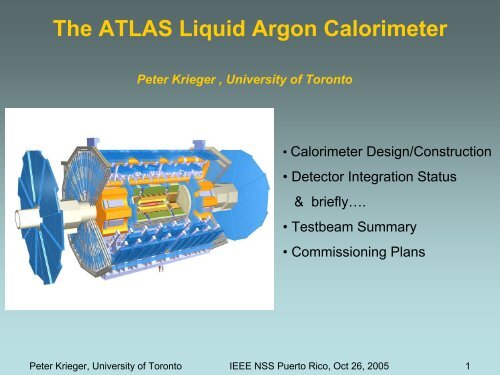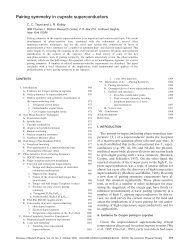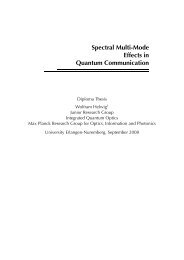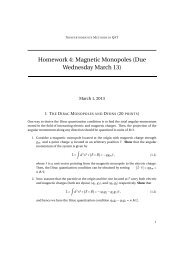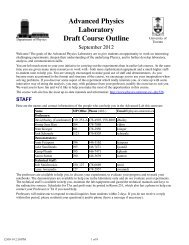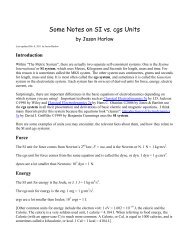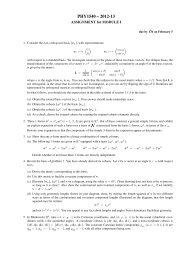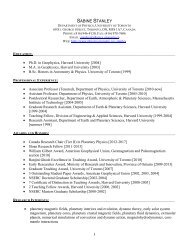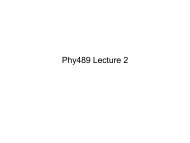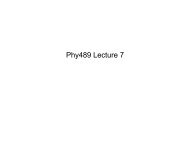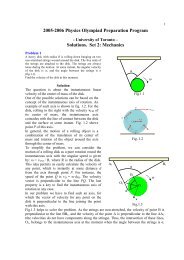The ATLAS Liquid Argon Calorimeter - University of Toronto
The ATLAS Liquid Argon Calorimeter - University of Toronto
The ATLAS Liquid Argon Calorimeter - University of Toronto
Create successful ePaper yourself
Turn your PDF publications into a flip-book with our unique Google optimized e-Paper software.
<strong>The</strong> <strong>ATLAS</strong> <strong>Liquid</strong> <strong>Argon</strong> <strong>Calorimeter</strong><br />
Peter Krieger , <strong>University</strong> <strong>of</strong> <strong>Toronto</strong><br />
• <strong>Calorimeter</strong> Design/Construction<br />
• Detector Integration Status<br />
& briefly….<br />
• Testbeam Summary<br />
• Commissioning Plans<br />
Peter Krieger, <strong>University</strong> <strong>of</strong> <strong>Toronto</strong> IEEE NSS Puerto Rico, Oct 26, 2005 1
<strong>The</strong> <strong>ATLAS</strong> Detector at the LHC<br />
Peter Krieger, <strong>University</strong> <strong>of</strong> <strong>Toronto</strong> IEEE NSS Puerto Rico, Oct 26, 2005 2
<strong>The</strong> <strong>ATLAS</strong> LAr and Tile <strong>Calorimeter</strong>s<br />
LAr hadronic<br />
end-cap (HEC)<br />
LAr EM end-cap (EMEC)<br />
LAr EM barrel<br />
Tile barrel Tile extended barrel<br />
LAr forward calorimeter (FCAL)<br />
Peter Krieger, <strong>University</strong> <strong>of</strong> <strong>Toronto</strong> IEEE NSS Puerto Rico, Oct 26, 2005 3
<strong>ATLAS</strong> EM Accordion <strong>Calorimeter</strong><br />
Electromagnetic Barrel (EMB) Electromagnetic Endcap (EMEC)<br />
Half Barrel<br />
Assembly<br />
Peter Krieger, <strong>University</strong> <strong>of</strong> <strong>Toronto</strong> IEEE NSS Puerto Rico, Oct 26, 2005 4
<strong>ATLAS</strong> Electromagnetic Barrel <strong>Calorimeter</strong><br />
|η| < 1.475<br />
Cu/kapton electrode<br />
Honeycomb spacer<br />
Stainless-steel-clad<br />
Pb absorber plates<br />
Detector design dictated by physics goals (high energy EM final states)<br />
e.g.<br />
→ → → ′ → , Ζ′ →<br />
0 0<br />
H γγ , H ZZ 4 e, W eνee Accordion structure chosen to ensure azimuthal uniformity (no cracks)<br />
<strong>Liquid</strong> argon chosen for radiation hardness and speed<br />
Peter Krieger, <strong>University</strong> <strong>of</strong> <strong>Toronto</strong> IEEE NSS Puerto Rico, Oct 26, 2005 5
Electromagnetic Barrel <strong>Calorimeter</strong><br />
Feedthrough<br />
<strong>Calorimeter</strong><br />
Presampler<br />
Solenoid<br />
Peter Krieger, <strong>University</strong> <strong>of</strong> <strong>Toronto</strong> IEEE NSS Puerto Rico, Oct 26, 2005 6
<strong>ATLAS</strong> Barrel Cryostat (October 2004)<br />
Peter Krieger, <strong>University</strong> <strong>of</strong> <strong>Toronto</strong> IEEE NSS Puerto Rico, Oct 26, 2005 7
Barrel Toroids Ready for Barrel <strong>Calorimeter</strong><br />
<strong>Calorimeter</strong> move to z=0 taking place today (Oct 26, 2005)<br />
Peter Krieger, <strong>University</strong> <strong>of</strong> <strong>Toronto</strong> IEEE NSS Puerto Rico, Oct 26, 2005 8
Installation <strong>of</strong> LAr Cryogenics<br />
Peter Krieger, <strong>University</strong> <strong>of</strong> <strong>Toronto</strong> IEEE NSS Puerto Rico, Oct 26, 2005 9
<strong>The</strong> <strong>ATLAS</strong> Endcap <strong>Liquid</strong> <strong>Argon</strong> <strong>Calorimeter</strong><br />
Electromagnetic<br />
Endcap <strong>Calorimeter</strong><br />
Hadronic Endcap <strong>Calorimeter</strong><br />
Forward<br />
<strong>Calorimeter</strong><br />
Cryogenic<br />
feedthroughs<br />
Peter Krieger, <strong>University</strong> <strong>of</strong> <strong>Toronto</strong> IEEE NSS Puerto Rico, Oct 26, 2005 10
<strong>ATLAS</strong> Hadronic Endcap <strong>Calorimeter</strong><br />
LAr-Cu sampling calorimeter<br />
covering 1.5 < η < 3.2<br />
Composed <strong>of</strong> 2 wheels per<br />
end, 32 modules per wheel<br />
HEC Module Structure<br />
Peter Krieger, <strong>University</strong> <strong>of</strong> <strong>Toronto</strong> IEEE NSS Puerto Rico, Oct 26, 2005 11
Endcap <strong>Calorimeter</strong> Insertion into Cryostat<br />
HEC wheel 1 insertion HEC wheel 2 insertion<br />
EMEC<br />
HEC1<br />
Peter Krieger, <strong>University</strong> <strong>of</strong> <strong>Toronto</strong> IEEE NSS Puerto Rico, Oct 26, 2005 12
Peter Krieger, <strong>University</strong> <strong>of</strong> <strong>Toronto</strong> IEEE NSS Puerto Rico, Oct 26, 2005 13
<strong>The</strong> FCal <strong>Calorimeter</strong> (η = 3.2-4.9)<br />
Novel electrode structure � thin annular gaps formed by an tubes in an<br />
absorber matrix, which are filled with anode rods <strong>of</strong> slightly smaller radius<br />
Gap maintained by helically-wound radiation hard plastic fibre (PEEK)<br />
Three modules: 1 EM, 2Hadronic (ease <strong>of</strong> construction, depth segmentation)<br />
Type Absorber<br />
Peter Krieger, <strong>University</strong> <strong>of</strong> <strong>Toronto</strong> IEEE NSS Puerto Rico, Oct 26, 2005 14<br />
Gap<br />
(µm)<br />
Number <strong>of</strong><br />
Electrodes<br />
FCal1 EM copper 250 12000<br />
FCal2 HAD tungsten 375 10000<br />
FCal3 HAD tungsten 500 8000<br />
matrix and rods are part <strong>of</strong> the<br />
detector ‘absorber’ and are<br />
composed <strong>of</strong> the same material
FCal2/3 Structure and Assembled Module<br />
<strong>Liquid</strong> <strong>Argon</strong> Gap<br />
Tungsten Rod<br />
Peter Krieger, <strong>University</strong> <strong>of</strong> <strong>Toronto</strong> IEEE NSS Puerto Rico, Oct 26, 2005 15
Forward <strong>Calorimeter</strong> Assembly<br />
FCal support tube<br />
Brass Plug<br />
Shielding<br />
Peter Krieger, <strong>University</strong> <strong>of</strong> <strong>Toronto</strong> IEEE NSS Puerto Rico, Oct 26, 2005 16
Peter Krieger, <strong>University</strong> <strong>of</strong> <strong>Toronto</strong> IEEE NSS Puerto Rico, Oct 26, 2005 17
Forward <strong>Calorimeter</strong> Installation<br />
Peter Krieger, <strong>University</strong> <strong>of</strong> <strong>Toronto</strong> IEEE NSS Puerto Rico, Oct 26, 2005 18
Forward <strong>Calorimeter</strong> Insertion<br />
Peter Krieger, <strong>University</strong> <strong>of</strong> <strong>Toronto</strong> IEEE NSS Puerto Rico, Oct 26, 2005 19
Peter Krieger, <strong>University</strong> <strong>of</strong> <strong>Toronto</strong> IEEE NSS Puerto Rico, Oct 26, 2005 20
Endcap Cryostat Move To LHC Point 1<br />
Peter Krieger, <strong>University</strong> <strong>of</strong> <strong>Toronto</strong> IEEE NSS Puerto Rico, Oct 26, 2005 21
<strong>Liquid</strong> <strong>Argon</strong> Front-End Electronics<br />
Common readout electronics for all LAr Calorimetry<br />
except for cold (GaAs) preamplifier for Hadronic Endcap <strong>Calorimeter</strong><br />
Installation and testing <strong>of</strong> Front-End Crates<br />
currently underway in <strong>ATLAS</strong> cavern<br />
Peter Krieger, <strong>University</strong> <strong>of</strong> <strong>Toronto</strong> IEEE NSS Puerto Rico, Oct 26, 2005 22
LAr Bipolar Signal Pulse Shaping<br />
physics pulse<br />
Amplitude carries<br />
the information (i 0 )<br />
equal<br />
areas<br />
Pulse shape sampled every 25 ns<br />
( eg. once / bunch crossing)<br />
Optimal shaping time is an<br />
optimization problem.<br />
Peter Krieger, <strong>University</strong> <strong>of</strong> <strong>Toronto</strong> IEEE NSS Puerto Rico, Oct 26, 2005 23
Electronic Calibration<br />
Pulse height samples � peak height via optimal filtering<br />
• Optimal Filtering (OFC) coefficients E (ADC) = ∑ a i (S i -PED)<br />
• OFC calculation relies on detailed knowledge <strong>of</strong> the physics pulse shape<br />
• Use calibration pulser: inject known current I 0 to calibrate response<br />
• But …. Calibration pulse differs from physics pulse<br />
– Physics pulse: triangular<br />
– Calibration pulse: exponential<br />
Physics<br />
Calibration<br />
Same I 0<br />
Calibration system requires<br />
detailed knowledge <strong>of</strong> the<br />
difference between the physics<br />
and calibration pulse shapes<br />
ADC[phys]/ADC[calib] for the<br />
same initial current I 0<br />
This can be tricky…..<br />
Procedure differs for different HEC, EM, FCal<br />
Peter Krieger, <strong>University</strong> <strong>of</strong> <strong>Toronto</strong> IEEE NSS Puerto Rico, Oct 26, 2005 24
LAr <strong>Calorimeter</strong> Testbeam Summary<br />
Testbeam programme (recent):<br />
� HEC/EMEC combined (2002) (Combined π response)<br />
� FCal Standalone (2003) (FCal Calibration)<br />
� HEC/EMEC/FCal Combined (2004) (Combined Endcap Response)<br />
� Barrel Combined Testbeam (2004) (Combined Barrel Response)<br />
Testbeams have served multiple purposes:<br />
� QC/QA during detector construction<br />
� Initial energy scale calibration: detector resolution, linearity<br />
� Investigation <strong>of</strong> crack/dead material effects<br />
� Exercise <strong>ATLAS</strong> electronics chain<br />
� Tests <strong>of</strong> online/<strong>of</strong>fline monitoring/reconstruction s<strong>of</strong>tware<br />
Peter Krieger, <strong>University</strong> <strong>of</strong> <strong>Toronto</strong> IEEE NSS Puerto Rico, Oct 26, 2005 25
<strong>Calorimeter</strong> Commissioning Plans<br />
� Coldtesting on the surface after detector integration (complete)<br />
� Testing (warm) in the in <strong>ATLAS</strong> Cavern<br />
� Coldtesting in the <strong>ATLAS</strong> Cavern<br />
� Electronic calibration, noise studies…<br />
� Commissioning/integration <strong>of</strong> trigger/DAQ system<br />
� Data taking with cosmic ray events begins in early 2006<br />
� LAr Barrel (early 2006)<br />
� LAr Endcaps (summer 2006)<br />
� Commissioning with single-beams in 2007<br />
� Commissioning with colliding beams in 2007<br />
Peter Krieger, <strong>University</strong> <strong>of</strong> <strong>Toronto</strong> IEEE NSS Puerto Rico, Oct 26, 2005 26
Backup Slides for Testbeam Setups<br />
Peter Krieger, <strong>University</strong> <strong>of</strong> <strong>Toronto</strong> IEEE NSS Puerto Rico, Oct 26, 2005 27
Summary <strong>of</strong> <strong>Calorimeter</strong> Testbeams<br />
EM Barrel<br />
Tile Barrel<br />
2004 H8 Barrel CTB<br />
EM Endcap<br />
Hadronic<br />
Endcap<br />
Tile Extended<br />
Barrel<br />
Forward<br />
2002 H6<br />
EMEC/HEC<br />
2004 H6<br />
EMEC/HEC/<br />
FCAL<br />
2003 H6<br />
FCAL<br />
Peter Krieger, <strong>University</strong> <strong>of</strong> <strong>Toronto</strong> IEEE NSS Puerto Rico, Oct 26, 2005 28
Barrel Combined Testbeam (<strong>ATLAS</strong> Full Slice)<br />
<strong>Calorimeter</strong> component: Experimental setup:<br />
• Tile barrel modules:<br />
– Three radial layers (1.4 λ, 3.9 λ and 1.8 λ each)<br />
– Total number <strong>of</strong> cells: 134<br />
• LAr barrel module:<br />
– Three radial layers + presampler (24 X 0 globally)<br />
– Total number <strong>of</strong> cells: 2031<br />
Peter Krieger, <strong>University</strong> <strong>of</strong> <strong>Toronto</strong> IEEE NSS Puerto Rico, Oct 26, 2005 29
H8 Barrel Combined Testbeam Setup<br />
Peter Krieger, <strong>University</strong> <strong>of</strong> <strong>Toronto</strong> IEEE NSS Puerto Rico, Oct 26, 2005 30
R [cm]<br />
Endcap Combined Testbeam (Crack Studies)<br />
60<br />
50<br />
40<br />
30<br />
20<br />
10<br />
0<br />
Poly shield<br />
elm EndCap<br />
pumps<br />
had EndCap had EndCap<br />
(front) (back)<br />
FCal I FCal II FCal III<br />
(elm) (had) (had)<br />
350 400 450 500 550 600 650<br />
Z [cm]<br />
Forward cone ~ projective.<br />
Dead material<br />
Same region is overlap <strong>of</strong> HEC<br />
and EMEC: loss <strong>of</strong> response<br />
Cu shielding η=3.2<br />
Peter Krieger, <strong>University</strong> <strong>of</strong> <strong>Toronto</strong> IEEE NSS Puerto Rico, Oct 26, 2005 31
HEC/EMEC FCAL combined test beam run<br />
Cold tailcatcher<br />
EMEC+HEC+FCAL Setup Material studies<br />
Special HEC mini-Modules<br />
FCal1/2 Mod0<br />
EMEC Mod0<br />
Peter Krieger, <strong>University</strong> <strong>of</strong> <strong>Toronto</strong> IEEE NSS Puerto Rico, Oct 26, 2005 32
Peter Krieger, <strong>University</strong> <strong>of</strong> <strong>Toronto</strong> IEEE NSS Puerto Rico, Oct 26, 2005 33
HEC/EMEC Combined Testbeam (2002)<br />
Hadrons, electrons and muons: E(beam) = 6-200 GeV η = 1.6 – 1.8<br />
90° impact angle (unlike <strong>ATLAS</strong>)<br />
Results now published<br />
NIM A531 (2004) 481<br />
HEC2<br />
HEC1<br />
EMEC<br />
Peter Krieger, <strong>University</strong> <strong>of</strong> <strong>Toronto</strong> IEEE NSS Puerto Rico, Oct 26, 2005 34


